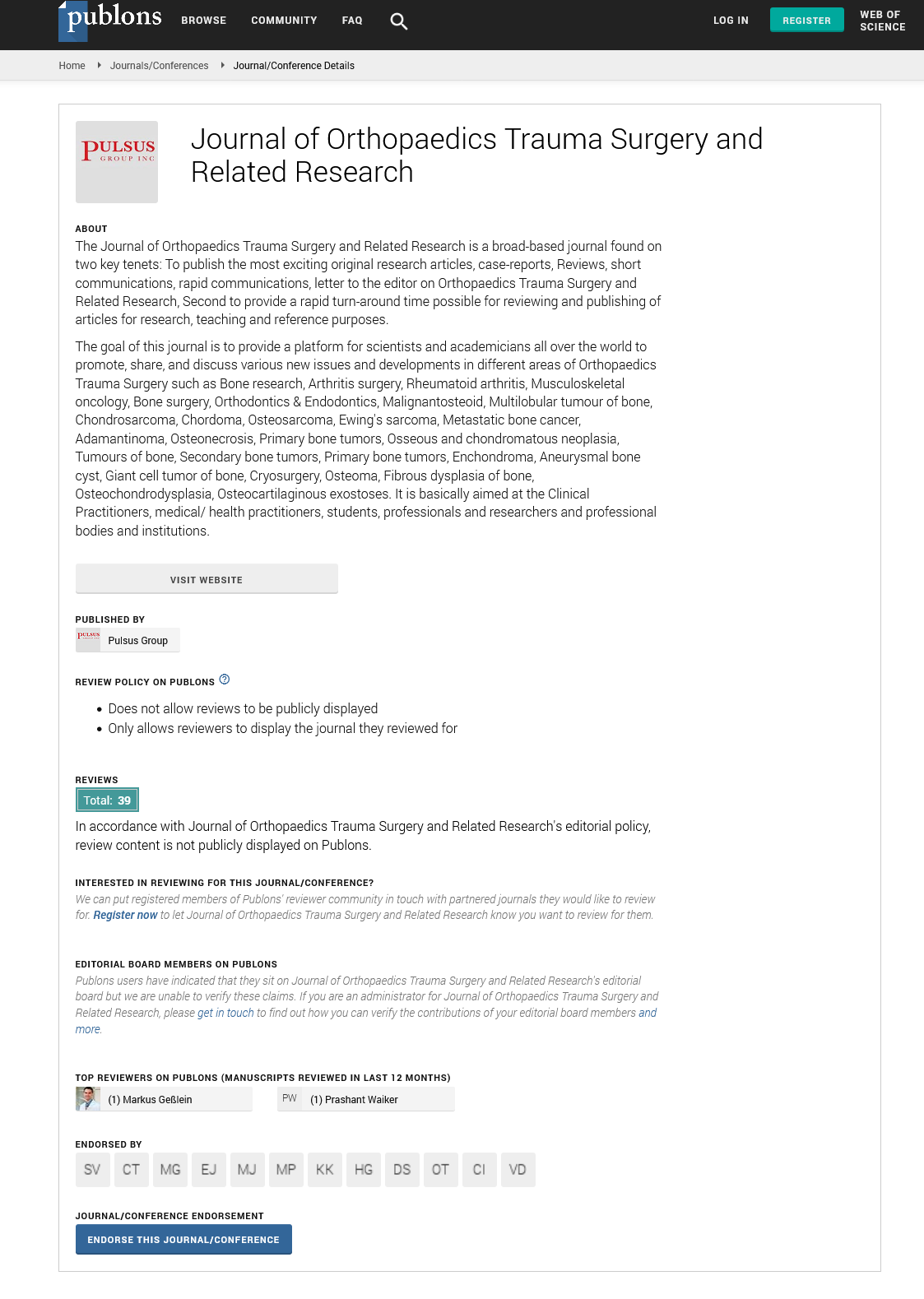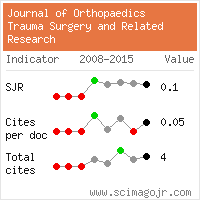Elbow kinematics in radial head replacement versus radial head excision versus radial head fixation: A comparative study
Received: 29-May-2022, Manuscript No. JOTSRR-22-65313; Editor assigned: 31-May-2022, Pre QC No. JOTSRR-22-65313 (PQ); Accepted Date: Jun 21, 2022 ; Reviewed: 14-Jun-2022 QC No. JOTSRR-22-65313 (Q); Revised: 16-Jun-2022, Manuscript No. JOTSRR-22-65313 (R); Published: 23-Jun-2022, DOI: 10.37532/1897- 2276.2022.17(6).72
This open-access article is distributed under the terms of the Creative Commons Attribution Non-Commercial License (CC BY-NC) (http://creativecommons.org/licenses/by-nc/4.0/), which permits reuse, distribution and reproduction of the article, provided that the original work is properly cited and the reuse is restricted to noncommercial purposes. For commercial reuse, contact reprints@pulsus.com
Abstract
Radial head fractures account for approximately 4% of all fractures, 10% associated with elbow dislocation and 33% of elbow fractures .The radial head acts as a secondary stabilizer in medial collateral ligament deficiency and provides around 30% resistance to valgus. Radial head fracture thus needs to be replaced, fixed or excised to maintain stability at the elbow joint. Fractures of the radial head are classified according to Modified Mason’s classification.
Keywords
fractures, polytrauma, external fixation, pelvic fractures, unstable pelvic ring, orthopaedic damage.
Introduction
In 1926 Cutler recognized direct trauma as the commonest cause of injury to the radial head [1-4]. According to static loading studies around 60% of the force is transmitted across the radio capitellar articulation [5, 6]. Radial head excision has been a popular choice of management for comminuted fractures throughout the years and stiffness in the elbow is the most common complication following the fracture even in the displaced ones. For fixation ideally, the fracture should have 3 or fewer fragments and these fragments must be large enough to accept a screw. Implants for radial head replacement have evolved over time from monoblack design to modular prostheses, few of which even have bipolar features. With the advent of different implant materials, the chances of capitellar wear have also decreased. Comminuted radial head fractures can be managed by excision, fixation or arthroplasty of the radial head. The aim of our study is to compare the results of excision, fixation and arthroplasty, in comminuted fractures of the radial head.
Materials and Methods
The study comprises of 60 patients between the age group of 20 years-60 years (37 male, 23 female) with an average age of 50 years [7].
THE INCLUSION CRITERIA WERE AS FOLLOWS:
1. Mason’s Type 3 radial head fractures. 2. Age of patient between 20 years-60 years. 3. Not more than 2 weeks delayed presentation. 4. No ligament injury.
EXCLUSION CRITERIA WERE AS FOLLOWS:
1. Compound radial head fractures. 2. Radial head fracture associated with other fractures of upper limb. 3. Associated ligament injury with radial head fracture. 4. Written informed consent was taken. Clinical examination and radiological evaluation were done. Pre-operative routine workup was done for the patients. Following randomization, 20 patients each were included in the excision group, fixation group and arthroplasty group [8,9].
THE TECHNIQUE OF RADIAL HEAD EXCISION
The patient is supine with the arm across the chest and affected elbow up. The incision is initiated superiorly to the lateral condyle and extended 6 cm distally across the joint. Interval between extensor carpi ulnaris and anconeus is created and used to expose the lateral capsule. The annular ligament is incised transversely. The fractured radial head was excised. Reconstruction of the radial head is done on the operation table to avoid leaving any fragments behind. The wound was closed in layers.
THE TECHNIQUE OF RADIAL HEAD FIXATION
The patient is supine with an arm across the chest and affected elbow up. An incision is initiated superiorly to the lateral condyle and extended 6 cm distally across the joint. Interval between extensor carpi ulnaris and anconeus is created and used to expose the lateral capsule. The annular ligament is incised transversely. The fracture site was exposed and cleaned. Primary reduction is fixed using k wires. The small plate is fixed on the lateral surface of the proximal radius while keeping the wrist in a neutral position. The annular ligament and lateral capsule were repaired. The wound was closed in layers.
THE TECHNIQUE OF RADIAL HEAD ARTHROPLASTY
The patient is supine with the arm across the chest and affected elbow up. An incision is initiated superiorly to the lateral condyle and extended 6 cm distally across the joint. Interval between extensor carpi ulnaris and anconeus is created and used to expose the lateral capsule. The annular ligament is incised transversely and the radial neck is cut just proximal to the fracture site. Head sizes with diameters of 14 mm to 20 mm with a stem size of 5 mm were available. Reaming initiated with 3 mm size with 1 mm increment until size 5 mm. The trial prosthesis is used first and after a satisfactory result and range of motion, the final implant is inserted. Lateral capsule and annular ligament repair done. The wound was closed in layers.
Follow-Up
Immediately after the surgery active range-of-motion exercises of the elbow were started. Suture removal was done between the 10th to 12th postoperative days. The cases were followed up after 2 weeks till 1 month, after that till the acceptable range of motion was regained. After that, the patient was followed up every 3 months. The results were analysed by the Mayo elbow performance score and Handgrip scoring system using a dynamometer. Statistical analysis was done using the One-way ANOVA test. According to biomechanical studies activities of daily living can be performed without discomfort within a functional arc of motion of elbow flexion-extension of 100°, and forearm rotation of about 100° (pronation 50° to supination 50°).
Assessment of range of motion of elbow in our study groups shows a better range of motion in a patient with radial head replacement as compared to excision and the range of motion being better in excision as compared to fixation. Patients were evaluated at 6 and 18 months based on the Mayo Elbow Performance Score and Handgrip strength score.
Results
At 6 months, radial head arthroplasty gave excellent results in 10 patients, good in 7 patients and fair in 3 patients. In excision, there were 4 patients with excellent results at 6 months, 9 with good results and 7 with fair results. In fixation, there were 4 patients with excellent results at 6 months, 7 with good results and 9 with fair results. At 18 months, of the 20 patients who had undergone arthroplasty, 12 had excellent results, 5 patients had good results and 3 had fair results. Of the 20 patients who had undergone head excision, 8 had excellent results, 8 patients had good results and 4 patients had fair results. 6 of the 20 cases who had undergone radial head fixation had excellent results; good results were obtained in 5 cases and 8 patients showed poor results at 18 months. As per Mayo’s score at 6 months follow-up, the mean and Standard Deviation (SD) of the scores in arthroplasty were 83.25 and 4.50, for excision, it was 75.75 and 11.38 & for fixation, it was 68.75 and 17.83 respectively. At 18 months of follow-up, the mean and standard deviation was 90 and 12.56 for arthroplasty, 83 and 10.05 for excision & 75.75 and 22.31 for fixation respectively. As per the handgrip strength score at 6 months follow-up, the mean and standard deviation of the scores in arthroplasty were 31.1 and 4.37, for excision it was 28.75 and 4.27 & for fixation, it was 26.47 and 5.96 respectively. At 18 months of follow-up, the mean and standard deviation was 32.95 and 4.006 for arthroplasty, 30.7 and 4.06 for excision & 27.63 and 6.73 for fixation respectively. The difference between the results according to both Mayo’s score as well as Handgrip strength test was statistically significant (p<0.05).
Discussion
With various surgical options (ORIF, excision and arthroplasty) available for the management of Mason type III radial, the treatment protocol to be preferred still remains a grey area in the field of orthopaedics. Proximal radial epiphysis has a scanty blood supply. It is supplied by small intraarticular vessels and a few intraosseous vessels [8]. Yamaguchi et al concluded in their study that intraosseous vessels are the primary blood supplier to the radial head [9]. For fixation ideally, the fracture should have 3 or fewer fragments and these fragments must be large enough to accept a screw for fixation and should have minimal metaphysical bone loss, thus making fixation a difficult entity. Fixation leads to complications like osteonecrosis, nonunion, or displaced fragments According to a study conducted by Daphne et al on the effect of radial head excision and arthroplasty on elbow kinematics and stability, radial head excision alters the kinematics and varus-valgus laxity of the elbow which can be improved after radial head arthroplasty. The prosthetic replacement of fractured radial head helps in maintaining longitudinal radioulnar stability and radicapitellar relationship. Ikeda et al in their study concluded that fixation of comminuted radial head fracture gave better outcome in comparison to excision. Swensen et al, in their study about maximizing outcomes in treatment of radial head fractures, concluded that current evidence supports open reduction and internal fixation of simple Mason type II fractures whereas good to excellent results have been seen with radial head replacement in patients with Mason type III fractures. Hao Sun et al, revealed that radial head arthroplasty has better outcome than ORIF in patients with modified Mason type III and IV radial head fractures.
References
- Duckworth AD, Clement ND, Jenkins PJ, et al. (2012) The epidemiology of radial head and neck fractures. J Hand Surg Am 37(5):112-119. [Google Scholar]
- Broberg MA, Morrey BF. Results of treatment of fracture-dislocations of the elbow. Clin Orthop. 1987;216:109-19. [Google Scholar]
[CrossRef]
- Mason ML. Some observations on fractures of the head of the radius with a review of one hundred cases. Br J Surg. 1954;42:123-32. [Google Scholar]
[CrossRef]
- Johnston GW. A follow-up of one hundred cases of fracture of the head of the radius with a review of the literature. Ulster Med J. 1962; 31:51-6. [Google Scholar]
[CrossRef]
- Putz R, Milz S, Maier M, Boszczyk A. Functional morphology of the elbow joint. Orthopade. 2003; 32:684-90. [Google Scholar]
[CrossRef]
- Kapandji IA. The Physiology of the Joints. Vol. 1. Edinburgh, London: E&S Livingstone, 1970:84. [Google Scholar]
[CrossRef]
- Yamaguchi K, Sweet FA, Bindra R, The extraosseous and intraosseous arterial anatomy of the adult elbow. J Bone Joint Surg 79:1653-1662, 1997. [Google Scholar]
[CrossRef]
- Singh AK, Jidge A, Ramteke U, Venkateswaran N, et al. Functional Outcome of Elbow Kinematics in Radial Head Excision Versus Radial Head Replacement: A Comparative Study. Open Access Maced J Med Sci. 2019 15;7(9):1505-150.. [CrossRef] [Google Scholar]
- Prevenzas N. Evolution of pelvic and acetabular surgery from ancient to modern times Injury 2007 Apr;38(4):397-409. [Google Scholar]
[CrossRef]



 Journal of Orthopaedics Trauma Surgery and Related Research a publication of Polish Society, is a peer-reviewed online journal with quaterly print on demand compilation of issues published.
Journal of Orthopaedics Trauma Surgery and Related Research a publication of Polish Society, is a peer-reviewed online journal with quaterly print on demand compilation of issues published.